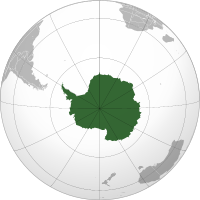
Photo from wikipedia
Strong wind events (SWEs) over Antarctica and its surrounding oceans are investigated using gridded surface wind data from the ERA-Interim for the 1979–2017 period. Throughout the year, SWEs are more… Click to show full abstract
Strong wind events (SWEs) over Antarctica and its surrounding oceans are investigated using gridded surface wind data from the ERA-Interim for the 1979–2017 period. Throughout the year, SWEs are more prevalent over the coastal region of East Antarctica where mean surface wind speeds are also higher. The occurrences of SWEs appear to be accompanied by positive anomalies in surface temperature and negative (positive) anomalies in mean sea level pressure related to cyclone (anticyclone) activity over the Ronne and Ross Ice Shelves and coastal regions (the inland areas of East Antarctica). The interannual variability of the SWE occurrences appears to be related to the southern annular mode (SAM) and, to a lesser degree, ENSO. The trends of SWE in the recent four decades exhibit considerable regional variations that are consistent with the trends in seasonal mean wind speed and surface air temperature, and can be largely explained by the variations in the sea level pressure trends across the region.
Journal Title: Journal of Climate
Year Published: 2019
Link to full text (if available)
Share on Social Media: Sign Up to like & get
recommendations!